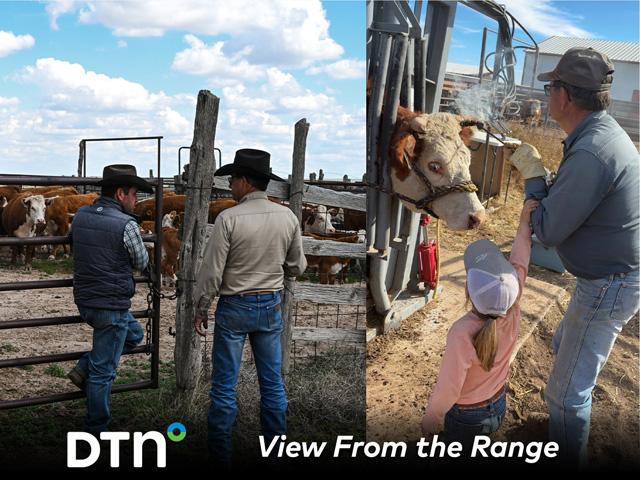Market Matters Blog
Polar Vortex Adds to Rail, Barge Traffic Problems
Polar vortex mania took over the cable news channels this week, and I have to admit that watching my fellow journalists do second grade science experiments, like throwing cups of boiling water into the air and watching it turn to snow, was amusing.
One angle you don’t see on those shows, however, is the impact the frigid temperatures on non-air travel transportation industries, like the barge and rail modes that are vitally important to agriculture markets.
Today, I’m lucky because two experts are going to explain it for me. The first is DTN Cash Grains Analyst Mary Kennedy, who tackles the topic in the form of her regular transportation blog. The second is Mike Steenhoek, executive director of the Soybean Transportation Coalition, who sent out a memo today. Many of Mike’s comments closely resembled Mary’s, so for the readers’ sake, I’ve trimmed them down a bit.
Barge, Rail Traffic Hurt By Cold Weather
P[L1] D[0x0] M[300x250] OOP[F] ADUNIT[] T[]
By Mary Kennedy
DTN Cash Grains Analyst
Early this week, both the BNSF and CN announced weather related delays to service on their rail lines and interchanges. With most of the U.S. and much of Canada blanketed in snow or extreme cold this past week, the service problem was widespread. Besides the winter weather related delays, the USDA weekly Grain Transportation Report said, "There are some complaints that sufficient locomotives are not available to haul grain because they are being used to haul crude oil from the growing shale-oil business instead." It's no secret that tank cars have almost overtaken grain cars on all of the railroads and, according to industry experts, it will only get worse. According to the Canadian Energy Resource Institute, oil moving by rail may increase in the next 3 to 5 years, and in the U.S, some oil companies are already expanding loading terminals to allow for more rail shipments. Recent derailments in North Dakota and Canada, however, are sending up red flags about the safety of oil moving through towns that sit on rail lines. Adding to the fear is the recent safety warning issued by the Pipeline and Hazardous Materials Safety Administration that Bakken oil may be more flammable than other crude oil.
While the cost of rail freight in the secondary market was slightly lower this week, many shippers have thrown their hands in the air as cars are still taking weeks to get placed. Once cars do get placed, shippers report that loaded cars sit on track for days waiting for power. Shuttle turn times are still behind with shippers reporting 2 turns per month versus the normal 3 turns. For the week ending January 2nd, bid/offers per car for January shuttle freight in the secondary market were at $1,679 above tariff, $52.50 per car lower than the prior week. The bid/offers per car for non-shuttle freight were $400 above tariff, $250 lower than the prior week. The lack of grain movement continues to spur the spot spring wheat basis higher with levels trading $3.00 to $4.00 above the MGEX March futures.
Shippers who rely on barges to move their products, especially soybeans to the Gulf, are also facing weather related problems. River soybean basis levels have been firm as the demand for soybeans at the Gulf continues. But shippers along the Illinois River and on the Mississippi River at St. Louis are having problems loading and moving barges. Ice accumulations have hampered efforts in both places. On top of that, the river at St. Louis is still at low levels, creating dangerous conditions for barges. There were reports that two tows ran aground in St. Louis on Wednesday, closing the river there until the barges can be refloated. Tows are facing restrictions as to how many barges they can push, and on the Illinois River, the maximum currently allowed is 12 barges vs. the average tow size of 15 barges. The rock removal project at Thebes, Ill., has been halted due to the icing, but when it resumes, traffic will be slowed once again during the daylight hours.
Steenhoek makes a few additional points:
-- For soybean processors, biodiesel facilities, ethanol facilities, etc. any delay in service is of sizable concern. These facilities are designed to run at full capacity or at least with a consistent throughput that does not fluctuate from day to day. Most deliveries to these facilities occur via truck, which has been significantly hampered due to the weather. Most processing facilities are not simply able to make a double batch of product tomorrow if they receive no deliveries today. If a facility can't operate on a particular day, it can be quite difficult to recover from that.
-- An important backdrop to these logistical concerns is the fact that 80 percent of U.S. soybean exports occur between September and February. When the South American soybean harvest comes online during February, March, and April, U.S. soybean exports drop dramatically. Conversely, when the U.S. harvest occurs during the fall, South American soybean exports drop significantly. As a result, when we experience some sort of logistics or transportation delay during this critical period of the year, it causes great concern among U.S. soybean exporters. The soybean industry -- given the competitive pressure from South America -- does not enjoy the luxury of holding onto a shipment of soybeans for an elongated period of time and then resuming those shipments once the logistical constraint has been addressed without some sort of penalty or cost. While supply chain disruptions during this time of the year are of concern to corn and wheat shippers, these commodities have less competitive pressure from South America and therefore less immediate pressure to move product through the system to the ultimate destination.
© Copyright 2014 DTN/The Progressive Farmer. All rights reserved.



Comments
To comment, please Log In or Join our Community .